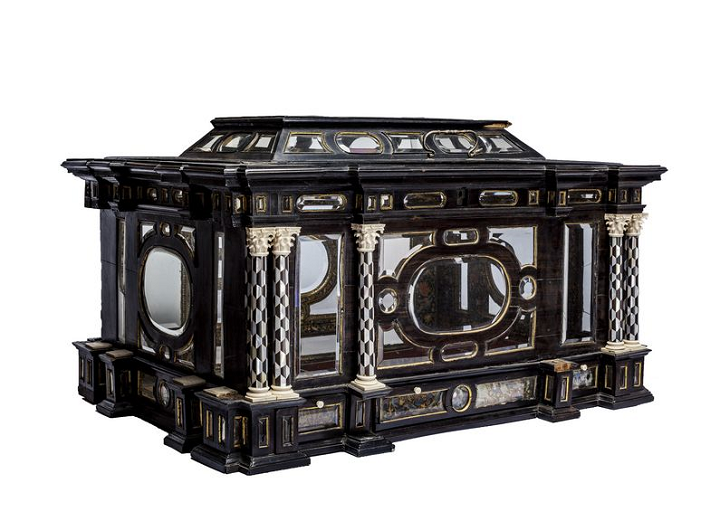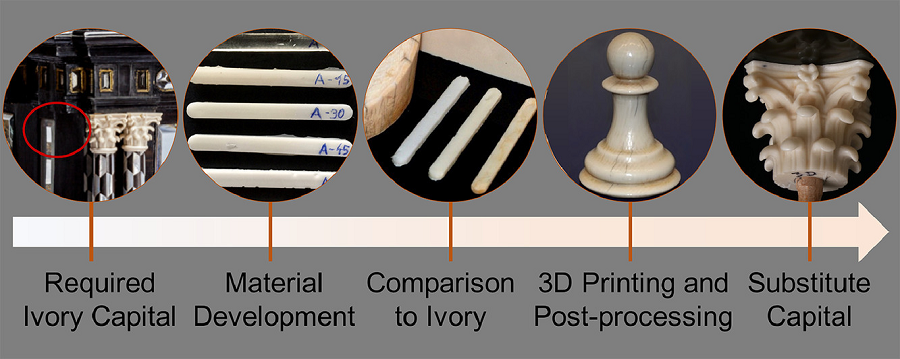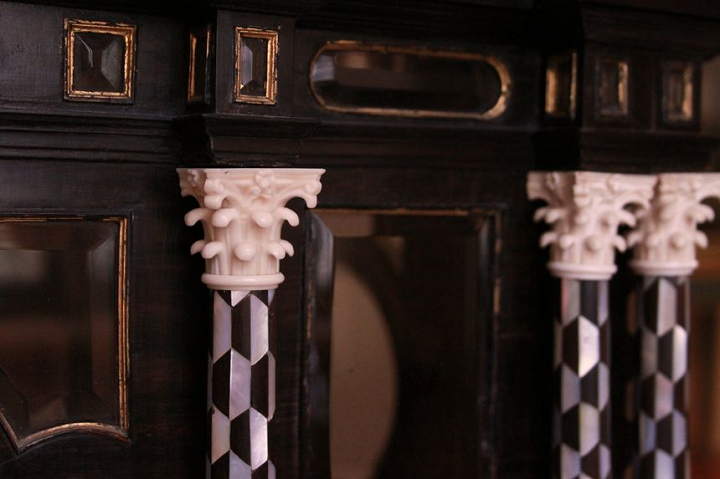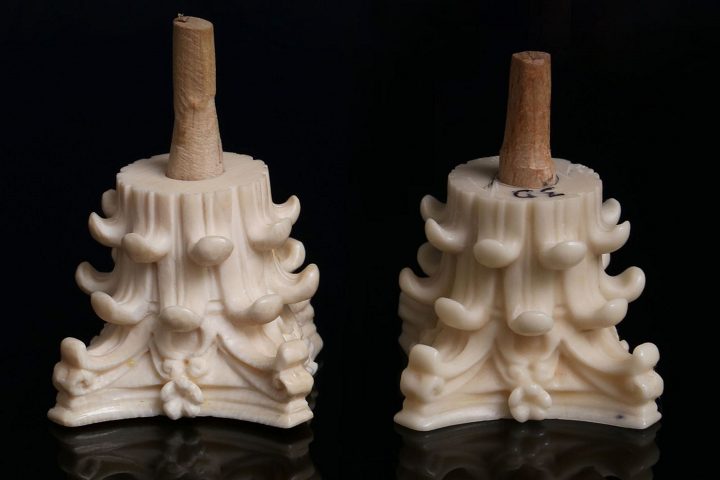Ivory, a hard, white material consisting mainly of dentine, makes up the tusks of several large animals, such as walruses, narwhals, and elephants. For a long time, the material was highly sought after for use in making artwork, but thankfully the ivory trade was banned internationally in 1989 to protect decreasing elephant populations. However, a lot of this intricate artwork, as well as ivory artifacts, is obviously still out there, and alternate materials, such as bones, plastic, and shells, are used to restore them, with middling results. But a partnership between the Vienna University of Technology (TU Wien) and Cubicure GmbH, the university’s spinoff company, has resulted in a 3D printable, elephant-friendly substitute for ivory that can be used to restore these pieces with high precision.
Through a cooperation with the Archdiocese of Vienna‘s Department for the Care of Art and Monuments and Vienna-based Addison Restoration KG, Cubicure and TU Wien have created Digory, a novel material made of calcium phosphate particles, silicon oxide powder, and synthetic resin. First processed in a hot, liquid state, Digory is hardened into the desired shape using UV rays, and once it’s off the printer, it can be polished and color-matched to a specific artifact or piece of art.
“The research project began with a valuable 17th-century state casket in the parish church of Mauerbach. It is decorated with small ivory ornaments, some of which have been lost over time. The question was whether they could be replaced with 3D printing technology,” explained Professor Jürgen Stampfl from TU Wien’s Institute of Materials Science and Technology.
The research team published a paper on their work using stereolithography-based 3D printing to create the ivory-like material.
“To restore sometimes very complex and delicate artefacts, it is economically reasonable to develop a substitute that can be built by additive manufacturing to reduce carving time and material waste. Such a substitute material should especially mimic the aesthetic characteristics of ivory by means of the colour, translucency and surface gloss. All merchantable 3D printable substitute materials have evidential limitations in exactly those important characteristics. The newly developed substitute material called “Digory” is processible with an additive manufacturing technique that derived from stereolithography,” they explained in the abstract.
The team has previously worked with ceramics for dental technology, so they had some experience with similar materials, but an ivory substitute was a tall order.
“We had to fulfil a whole range of requirements at the same time. The material should not only look like ivory, the strength and stiffness must also be right, and the material should be machinable,” explained Thaddäa Rath, who worked on the project for her dissertation.
“You also have to bear in mind that ivory is translucent. Only if you use the right amount of calcium phosphate will the material have the same translucent properties as ivory.”
The team spent lots of time experimenting before finally coming up with the right mixture to create the Digory material. They embedded tiny calcium phosphate particles, with an average 7 µm diameter, and very fine silicone oxide powder in a special resin, which is then processed at high temperatures in Cubicure’s hot lithography 3D printers.
“Layer by layer, a photosensitive slurry that consists mainly of a dimethacrylic resin filled with calcium phosphate particles is polymerized with a UV laser,” they explained in their paper. “The solids loading, which was adjusted to fit the translucency of ivory, was around 30 vol.%. At this content, the density of about 1.79 g cm−3 and the hardness of 35.7 HV0.2 are equivalent to the values for ivory found in the literature. Small quantities of yellow and red colour pigments were used to modify the basic colour. With further post-processing using traditional handcraft techniques, such as staining and polishing of the surface, an optical imitation of natural ivory was achieved.”
Once the item has been printed, it’s then polished and dyed to match the color of the artifact that is being restored, such as the ivory ornamentation on that 17th-century casket. The researchers reported good results using black tea for the touch-up work, and noted that you can also add the dark lines often seen running through ivory to the piece afterwards.
This is big news for the restoration field, as the team says that Digory is easier to work with than other substitutes, and replicates the stiffness, strength, and translucence of real ivory. Additionally, no elephants had to lose their tusks to restore an artifact, and 3D printing makes it possible to automatically, and quickly, reproduce the fine details of these pieces.
Cubicure’s Konstanze Seidler said, “With our specially developed 3D printing systems, we process different material formulations for completely different areas of application, but this project was also something new for us. In any case, it is further proof of how diverse the possible applications of stereolithography are.”
The researchers hope once the novel Digory material is further developed, it will become more accepted as “an aesthetically and mechanically high-quality” substitute for ivory, and can be used as a restoration material, as well as putting illegal poachers out of business.
(Source: New Atlas / Images: TU Wien)
Subscribe to Our Email Newsletter
Stay up-to-date on all the latest news from the 3D printing industry and receive information and offers from third party vendors.
You May Also Like
3D Printing News Briefs, November 9, 2024: Concept Car, Afloat 3D Printing, & More
In today’s 3D Printing News Briefs, we’ll start with business, as Anisoprint appointed AM industry veteran Tuan TranPham as President of the Americas and APAC. Then we’ll move onto automotive...
UpNano Lands €7M to Advance 2PP 3D Printing
Known for its hardware that can 3D print microscopic structures, UpNano has become an ally for industries like biomedicine and electronics. Now, the Austrian startup has landed a capital boost...
Zero Gravity, Big Impact: Ken Savin Talks Redwire’s Space Bioprinting Breakthroughs
In space, microgravity isn’t just a challenge—it’s an advantage. Redwire, known for pioneering space-based biomanufacturing, made history by sending the first bioprinter to the International Space Station (ISS) in 2019....
Boston’s Additive Edge: Engineering Heartbeats at Boston University’s Cutting-Edge Labs
At the crossroads of engineering and biology, Boston University (BU) is forging a new frontier in medical innovation. Within its state-of-the-art Chen and White Labs, researchers are pioneering breakthroughs in...







































